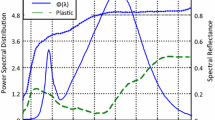Abstract
White LED is considered as a strong candidate for the future lighting technology. We have proposed an optical wireless communication system that employs white LEDs for indoor wireless networks. In this system, LED is used not only as a lighting device, but also as a communication device. The transmitter has large optical power and large emission characteristics to function as lighting device. And the system has specific wireless channel impulse response differing from infrared wireless communication. In this paper, we discuss about shadowing effect on the system utilizing plural LED lightings including the performance of ISI based on the impulse response. We consider the downlink transmission based on TDMA and evaluate the shadowing effect caused by pedestrians with computer simulation. When the shadowing often occurs at 800 Mb/s, the performance of outage call duration rate and blocking rate are improved by using 3 LED lightings compared with 1 or 2 LED lightings. And, we show that the system with the optimal number of the LED lighting is robust against shadowing and can accommodate more calls.
Similar content being viewed by others
References
S. Nakamura, “Present Performance of InGaN Based Blue/Green/Yellow LEDs”, in Proc. of SPIE Conference on Light-Emitting Diodes: Research, Manufacturing, and Applications, 3002, pp. 24–29, 1992.
C.P. Kuo, R.M. Fletcher, T.D. Osentowski, M.C. Lardizabal, M.G. Craford, and V.M. Robbins, “High Performance ALGaInP Visible Light-Emitting Diodes”, Applied Physics Letters, Vol. 57, No. 27, pp. 2937–2939, 1990.
Y. Tanaka, S. Haruyama, and M. Nakagawa, “Wireless Optical Transmissions with White Colored LED for Wireless Home Links”, in Proc. of the 11th International Symposium on Personal, Indoor and Mobile Radio Communications, September 2000, pp. 1325–1329.
T. Komine and M. Nakagawa, “Performance Evaluation of Visible-Light Wireless Communication System Using White LED Lightings”, in Proc. of the Ninth IEEE Symposium on Computers and Communications, June 2004, pp. 258–263.
Y. Tanaka, T. Komine, S. Haruyama, and M. Nakagawa, “Indoor Visible Light Transmission System Utilizing White LED Lights”, IEICE Transactions on Communications, Vol. E86-B, No. 8, pp. 2440–2454, August 2003.
T. Komine and M. Nakagawa, “Integrated System of White LED Visible-Light Communication and Power-Line Communication”, IEEE Transactions on Consumer Electronics, Vol. 49, No. 1, pp. 71–79, February 2003.
R.S. Berns, Billmeyer and Saltzman's Principles of Color Technology, John Wiley & Sons Inc., 2000.
F.R. Gfeller and U. Bapst, “Wireless In-House Data Communication via Diffuse Infrared Radiation”, in Proc. IEEE, Vol. 67, pp. 1474–1486, November 1979.
J.M. Kahn and J.R. Barry, “Wireless Infrared Communications”, in Proc. of the IEEE, Vol. 85, February 1997, pp. 265–298.
A.P. Tang, J.M. Kahn, and K.P. Ho, “Wireless Infrared Communication Links Using Multi-Beam Transmitters and Imaging Receivers”, in Proc. of IEEE International Conference on Communications, June 1996, pp. 180–186.
G.J. Foschini, B. Gopinath, and Z. Miljanic, “Channel Cost of Mobility”, IEEE Transactions on Vehicular Technology, Vol. 42, No. 4, pp. 414–424, November 1993.
A.J.C. Moreira, R.T. Valadas, and A.M.O. Duarte, “Optical Interference Produced by Artificial Light Wireless Networks”, Vol. 3, No. 2, pp. 131–140, 1997.
A. Sato, T. Ohtsuki, and I. Sasase, “Effects of Shadowing on Non-Directed LOS Indoor Infrared Wireless Systems with Site Diversity”, in Proc. IEEE Vehicular Technology Conference – Spring, Vol. 2, May 2000, pp. 1550–1554.
Author information
Authors and Affiliations
Corresponding author
Additional information
Toshihiko Komine was born in Shizuoka, Japan, on November 17, 1978. He received the B.E. and M.E. degrees in Information and Computer Science from Keio University, Yokohama, Japan, in 2001 and 2003 respectively. He is currently studying for the Ph.D. degree at Department of Information and Computer Science, Keio University. His current research interests are optical wireless communications and LED communications.
Shinichiro Haruyama is a professor at Department of Information and Computer Science, Faculty of Science and Technology, Keio University, Yokohama, Japan. He received an M.S. in engineering science from University of California at Berkeley in 1983 and a Ph.D. in computer science from the University of Texas at Austin in 1990. He worked for Bell Laboratories of AT{&}T and Lucent Technologies, U.S.A from 1991 to 1996, and for Sony Computer Science Laboratories, Inc. from 1998 to 2002. His research interests include reconfigurable system, system design automation, wireless communication, and visible light communication.
Masao Nakagawa was born in Tokyo, Japan in 1946. He received the B.E., M.E. and Ph.D. degrees in electrical engineering from Keio University, Yokohama, Japan, in 1969, 1971 and 1974 respectively. Since 1973, he has been with the Department of Electrical Engineering, Keio University, where he is now a Professor. His research interests are in CDMA, consumer Communications, Mobile communications, ITS (Intelligent Transport Systems), Wireless Home Networks, and Visible light Communication. He received 1989 IEEE Consumer Electronics Society Paper Award, 1999-Fall Best Paper Award in IEEE VTC, IEICE Achievement Award in 2000, IEICE Fellow Award in 2001. He was the executive committee chairman on International Symposium on Spread Spectrum Techniques and Applications in 1992 and the technical program committee chairman of ISITA (International Symposium on Spread Spectrum Techniques and Applications) in 1994. He is an editor of Wireless Personal Communications and was a guest editor of the special issues on “CDMA Networks I, II, III and IV” published in IEEE JSAC in 1994 (I and II) and 1996 (III and IV). He chairs the Wireless Home Link sub-committee in MMAC (Multimedia Mobile Access Communication Promotion Committee).
Rights and permissions
About this article
Cite this article
Komine, T., Haruyama, S. & Nakagawa, M. A Study of Shadowing on Indoor Visible-Light Wireless Communication Utilizing Plural White LED Lightings. Wireless Pers Commun 34, 211–225 (2005). https://doi.org/10.1007/s11277-005-8734-x
Issue Date:
DOI: https://doi.org/10.1007/s11277-005-8734-x




